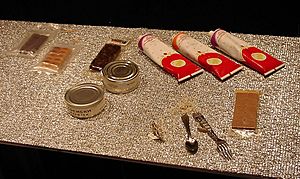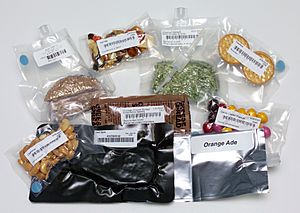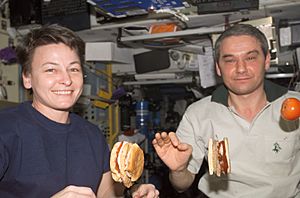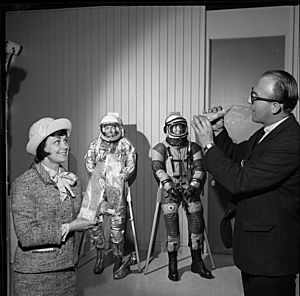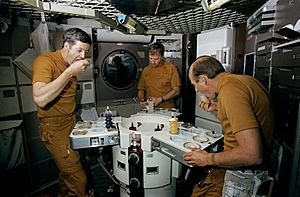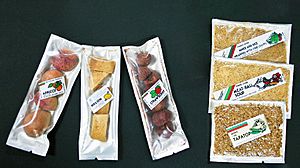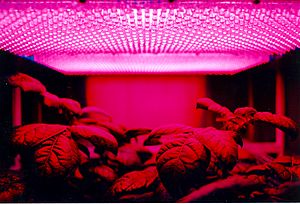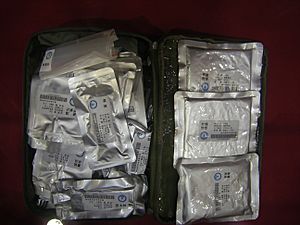Space food facts for kids
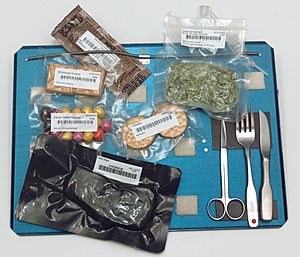
Space food is special food made for astronauts to eat when they are on missions in outer space. This food has to be just right to give astronauts all the energy and nutrients they need. It also needs to be easy and safe to store, prepare, and eat in a weightless environment, especially with all the equipment in a spacecraft. Most space food is freeze-dried, which means all the water is removed to help it last a very long time.
For many years, different countries have used space food to share their cultural identity and connect with each other. Even though astronauts now eat many different foods and drinks, the first idea back in 1963 was to give them only a special formula that had all the vitamins and nutrients they needed.
Contents
Types of Space Food
Space food comes in different kinds:
- Beverages (B) - These are drink mixes like coffee or tea that have been freeze-dried. They also include flavored drinks like lemonade. They come in special pouches that are sealed to keep air out.
- Fresh Foods (FF) - These are fresh fruits, vegetables, and tortillas that arrive on resupply missions. They spoil quickly, so astronauts need to eat them within a couple of days. These fresh foods help astronauts feel more at home, especially when they are away for a long time.
- Irradiated (I) Meat - This is meat, like beef steak, that has been treated with special energy (ionizing radiation) to stop it from spoiling. This method helps the food stay safe to eat for a long time.
- Intermediate Moisture (IM) - These foods have some moisture but not enough to spoil quickly. Examples are sausage and beef jerky.
- Natural Form (NF) - These are common foods you can buy in stores, like nuts, cookies, and granola bars. They are ready to eat and last a long time.
- Rehydratable (R) Foods - These foods have had their water removed using different methods, like freeze-drying. Astronauts add hot water to them before eating. Removing water stops tiny germs from growing.
- Thermostabilized (T) - This process, also called retort, heats food to kill germs and enzymes that cause spoilage. It's like how canned food is made.
- Extended Shelf-Life Bread Products - These are special scones, waffles, and rolls made to last up to 18 months.
Other common foods and condiments, like salt or pepper, are simply called by their names and don't have a special category.
Making Food for Space
Designing food for space is tricky! Space food must meet several important rules:
- It needs to be healthy, easy to digest, and taste good.
- It must be designed for a zero-gravity environment. This means it should be light, well-packaged, quick to serve, and easy to clean up after.
- It should not require much effort to use. It needs to store well, open easily, and leave very little waste. Foods that make crumbs, for example, are not good for space because crumbs would float everywhere.
Fizzy drinks have been tried in space, but they are not popular. In microgravity, the liquid and gas in your stomach don't separate, so burping can cause a "wet burp" (which is like throwing up a little). Coca-Cola and Pepsi were first flown in space in 1985.
Even special Beer has been made for space. It's designed to taste good even when astronauts' senses of taste and smell are dulled. It also has less fizz to prevent wet burps.
Making fresh bread in space has been a challenge. By 2012, scientists suggested a way to make dough rise using dissolved carbon dioxide instead of yeast. This could allow fresh bread to be baked on future spaceflights.
How Space Food is Packaged
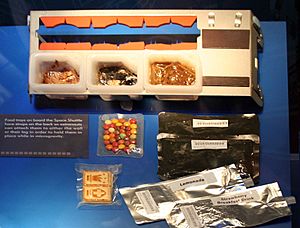
The main job of space food packaging is to keep the food safe and fresh. But the packaging also needs to be light, easy to throw away, and helpful for preparing the food. Each package has a barcode, which helps track what an astronaut eats. The labels also show how to prepare the food in both English and Russian.
Many foods from the Russian space program come in cans and tins. These are heated using electricity, opened with a can-opener, and the food is eaten right from the can. Russian soups are rehydrated and eaten directly from their packages.
NASA space foods are often in special retort pouches or are freeze-dried. They are also put into sealed containers that fit into trays. These trays have straps to attach them to a wall or an astronaut's leg. They also have clips to hold drinks or utensils in microgravity.
Cooking in Space
The International Space Station (ISS) has special machines to rehydrate and warm up packaged food. The first kitchen on the ISS was in the Russian part of the station. It had a system for rehydrating food and a food warmer for canned food. The United States later developed a portable food warmer. A second kitchen area was added to the Unity module when more astronauts started living on the station.
On the Tiangong Space Station in China, the kitchen is in the Tianhe core module. It has a small kitchen table for preparing food and the first-ever microwave oven in space! This means astronauts can always have hot food.
History of Space Food
Early space food was mostly small, bite-sized cubes, freeze-dried powders, and thick liquids in aluminum tubes. On the third Mercury mission in 1962, US astronaut John Glenn was the first to eat from an aluminum tube (it was applesauce!). But these tubes were eventually stopped because you couldn't smell or see the food, and the texture limited what kind of food could be offered.
Freeze-dried powders that could be rehydrated were also used. These had their own problems, but over time, the powders became easier to rehydrate, and the cubes were coated to stop them from crumbling. With the "spoon bowl" on the Apollo 8 mission, astronauts could open a package and eat with a spoon.
For lunch on Vostok 1 (1961), Yuri Gagarin ate pureed meat and chocolate sauce from toothpaste-like tubes.
In 1961, Soviet Cosmonaut Gherman Titov was the first person to get space sickness and vomit in space. This showed how important it was to have the right food for space travel.
John Glenn was the first American to orbit Earth in 1962. He tried eating in weightlessness. Some experts worried that swallowing would be hard, but Glenn had no trouble. It was found that microgravity does not stop the natural swallowing process.
Astronauts on later Mercury missions (1959–1963) didn't like their food. They found it unappetizing, hard to rehydrate, and didn't like squeezing tubes or picking up crumbs.
Gemini and Apollo Missions (1965–1975)
Many food problems from the Mercury missions were fixed for the later Gemini missions (1965–1966). Tubes were removed, coatings stopped cubes from crumbling, and rehydration became easier. The menus grew to include things like shrimp cocktail, chicken and vegetables, and apple juice.
On Gemini 3, astronauts Gus Grissom and John Young famously snuck a corned beef sandwich on board! Floating bread crumbs were a problem, so Grissom put the sandwich away quickly. NASA was not happy and promised to be more careful about what astronauts brought on future missions.
For the Apollo program (1968–1975), food options continued to expand. Hot water made rehydrating freeze-dried foods much easier and tastier. This was important because astronauts would spend more time in space. The "spoon-bowl" allowed for more normal eating. Food could be kept in special plastic containers, and moisture helped it stick to a spoon. However, the food often lacked strong taste because few spices were used. Astronauts often looked for foods with more flavor.
Skylab (1973–1974)
The Skylab space station (1973–1974) had larger living areas, including a refrigerator and freezer. This meant astronauts could store fresh and frozen foods. Skylab had a special dining area with a table and chairs that were fastened to the floor. This allowed for a more normal eating experience. The trays could warm food and had magnets to hold utensils. Because of these improvements, astronauts on Skylab had some of the best nutrition ever recorded in space.
The menu had 72 items, and for the first time, about 15% were frozen. Shrimp cocktail and butter cookies were favorites. Lobster Newberg, fresh bread, and ice cream were also available. Astronauts found the food better than on Apollo missions, but still sometimes unsatisfying. Frozen foods were the most popular, and spicy foods were liked because sinus congestion in weightlessness can dull taste and smell.
When American and Soviet crews met during the Apollo–Soyuz Test Project (1975), they shared food. The Soviet crew offered canned beef tongue, Riga bread, tubes of borscht (beet soup), and caviar.
Salyut Stations (1971–1986)
The Soviet Union's Salyut stations were the first to have separate areas for different activities, including a table for working and eating together. By the mid-1970s, cosmonauts on Salyut stations could eat fresh food like tomatoes and cucumbers from their space gardens. The first space-grown vegetables were reportedly eaten on Salyut 4 in 1975.
Interkosmos (1978–1988)
As part of the Interkosmos space program, countries like Bulgaria helped develop space technologies. A Bulgarian institute created space food for the program. Their menu included traditional Bulgarian dishes like tarator (a cold soup), sarma (stuffed cabbage rolls), musaka, lyutenitza (a relish), kiselo mlyako, and dried fruits and vegetables.
Space Food Today
International Space Station
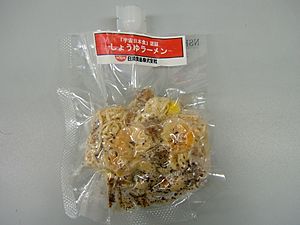
NASA wants the food experience on the ISS to be as much like Earth as possible. Astronauts have many main courses to choose from and can even ask for personalized menus with items like fruit salad and spaghetti. Fresh fruits and vegetables that can be stored at room temperature are also eaten. Astronauts sometimes ask for beef jerky because it lasts a long time and has a strong flavor. Food on the ISS is packaged individually for easy sharing and to prevent problems in microgravity. Because water is limited, more focus is on thermostabilized foods rather than those needing rehydration.
Since 2002, a small LADA Greenhouse system has been used on the ISS to study how plants grow in microgravity and to grow edible vegetables for astronauts.
- Italian: In 2015, Italian astronaut Samantha Cristoforetti was the first person to drink freshly brewed coffee in space. Companies developed an espresso machine called ISSpresso for the ISS. It can also make other hot drinks like tea and hot chocolate. This machine is not just for comfort; it's also an experiment to study how liquids behave in space.
- Japanese: The Japan Aerospace Exploration Agency (JAXA) has created traditional Japanese foods and drinks for space, such as matcha (green tea), yōkan (sweet bean paste), ramen, sushi, soups, and rice with ume (pickled plum). These foods were made with Japanese food companies.
- Korean: In 2008, South Korea’s first astronaut, Yi So-yeon, brought a special version of Korea's national dish, kimchi, to the ISS. It took years of research and a lot of money to make a version of this fermented cabbage dish suitable for space.
- Russian: On the ISS, the Russian crew can choose from over 300 dishes. A typical daily menu might include:
- Breakfast: Curds and nuts, mashed potatoes with nuts, apple sticks, sugarless coffee, and vitamins.
- Lunch: Jellied fish, borscht with meat, goulash with buckwheat, bread, black currant juice, sugarless tea.
- Supper: Rice and meat, broccoli and cheese, nuts, tea with sugar.
- Second supper: Dried beef, cashew nuts, peaches, grape juice.
- Swedish: Swedish astronaut Christer Fuglesang was not allowed to bring reindeer jerky on a mission because it seemed "weird" to the Americans before Christmas. He had to bring moose jerky instead.
NASA's Advanced Food Technology Project (AFT) is looking into ways to provide enough food for very long space missions. This research focuses on preventing health problems caused by long spaceflights, like weight loss and dehydration. The AFT aims to create space foods that reduce these issues.
Chinese Space Program
In 2003, China launched its first crewed spaceflight, Shenzhou 5. The astronaut, Yang Liwei, ate specially prepared yuxiang pork, Kung Pao chicken, and Eight Treasures rice, along with Chinese herbal tea. Food made for this flight has even been sold to the public.
On the Tiangong space station, astronauts have 120 different types of food, chosen based on their favorites. These include shredded pork in garlic sauce, kung pao chicken, black pepper beef, and various teas and juices. Fresh fruits and vegetables are kept in coolers. Most food is solid, boneless, and in small pieces. Condiments like pork sauce and Sichuan pepper sauce are used to help with changes in taste in microgravity.
China's Tiangong-2 station has also experimented with growing food in space, like thale cress (an edible weed) and rice. The station also hosts silkworms as an experiment to see if they could be a source of protein on long space missions.
Future Long Missions
A lot of work is being done to create food and packaging for very long space missions (over 2.5 years). The main goal is to provide tasty and healthy food while keeping its size, weight, and waste to a minimum.
Reducing waste is very important for long missions. Scientists are focusing on packaging that can break down, be eaten, or be reused. This will help reduce the amount of trash. Making foods last longer also helps reduce waste.
Research is also looking into food systems for missions to the Moon and other planets. A big part of this is growing crops, with the idea that plants grown without soil (hydroponically) will make up most of the menu. Early ideas for crops include white and sweet potatoes, soybeans, wheat, and rice. Growing plants also helps produce oxygen and control carbon dioxide in the spacecraft.
Scientists are making sure astronauts get not only enough nutrients for their health but also the right amounts needed for long spaceflights. Research shows that nutritional needs change the longer someone stays in space. For example, the recommended amount of calcium goes up for long missions.
Space Food for Everyone
Taking advantage of the popularity of the Apollo space missions in the early 1970s, a company called Pillsbury sold "Food Sticks" (also known as "Space Food Sticks") to the public. These were marketed as a healthy snack between meals and came in flavors like peanut butter and chocolate.
You can find examples of space-inspired products in gift shops at space centers, candy stores, or online. A popular example is freeze-dried ice cream. Tang, a drink mix, became very popular in the 1960s because it was included on American spaceflights.
See also
 In Spanish: Alimento espacial para niños
In Spanish: Alimento espacial para niños
- Airline meal
- HI-SEAS
- Meal, Ready-to-Eat


